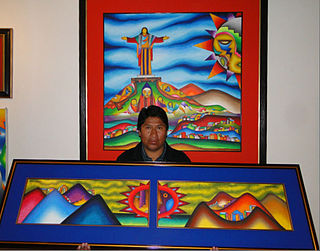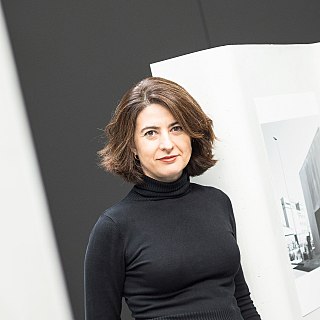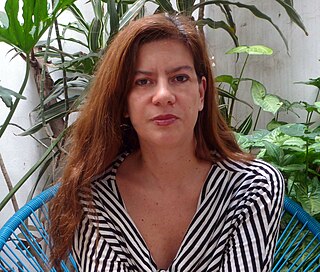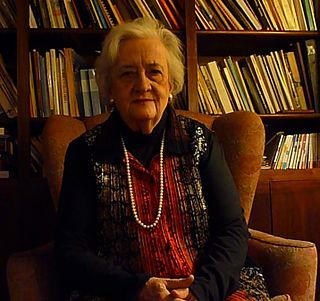
Ricardo Bofill Leví was a Spanish architect from Barcelona, Spain. He founded Ricardo Bofill Taller de Arquitectura in 1963 and developed it into a leading international architectural and urban design practice. According to architectural historian Andrew Ayers, his creations rank "among the most impressive buildings of the 20th century."

El Alto is the second-largest city in Bolivia, located adjacent to La Paz in Pedro Domingo Murillo Province on the Altiplano highlands. El Alto is today one of Bolivia's fastest-growing urban centers, with an estimated population of 943,558 in 2020. It is also the highest major city in the world, with an average elevation of 4,000 m (13,123 ft).

Roberto Aguilar Quisbert, better known as Roberto Mamani Mamani, is a Bolivian artist. Roberto Mamani Mamani is a self-taught, first-generation indigenous artist from Bolivia. who also goes by the name Roberto Aguilar Quisbert. The media Mamani Mamani works with are drawing and painting. Robert's art is driven by the inspiration of his culture and traditions, resulting in his work to become very colorful in order to mimic traditional colorful clothing that is worn in his culture.

Teodoro González de León was a Mexican architect.
Carlos Arroyo Zapatero is a contemporary architect, urbanist and critic from Madrid, Spain. His work claims to set the frame for a new architectural culture, language and aesthetics, through the ethics, technology and parameters of sustainability. He claims that his architecture is not designed to be photographed, but to be lived-in and enjoyed through time. He has developed a diagrammatic graphic style for his presentations which is inspirational for a whole generation of architects. In contrast, his built work is often portrayed by photographer-artists, producing innovative formats like photo-novellas, gif's, or video. His work has been exhibited in internationally renowned venues like the Venice Biennale, the Institut Français d'Architecture, presented in referential publications like El Croquis, and quoted by many bloggers in the sphere.

Ricardo Bofill Taller de Arquitectura (RBTA) is an architecture firm that was founded in 1963 by Ricardo Bofill, initially as Taller de Arquitectura (lit. 'Architecture Workshop'). It is headquartered in Sant Just Desvern near Barcelona, in a former cement factory known as La Fábrica.

ArchDaily is a website covering architectural news, projects, products, events, interviews and competitions, opinion pieces, among others, catering to architects, designers and other interested parties.
Temple Beth El of Northern Westchester is a Reform Jewish congregation and synagogue located at 220 South Bedford Road, in Chappaqua, Northern Westchester, New York, in the United States.

Carmen Espegel Alonso, is a Doctor of Architecture at the Escuela Técnica Superior de Arquitectura de Madrid (Spain), where she teaches Architectural Project classes representing the Espegel Teaching Unit. She has been working at her own studio since 1985 and in 2003 she founded the firm espegel-fisac arquitectos. Her reference work, "Heroines of Space. Women Architects in the Modern Movement", is a theoretical and historical synthesis of the role of women in Architecture.

Fernando Huanacuni Mamani is a Bolivian politician, lawyer and researcher. He served as the Foreign Minister of Bolivia from 2017 to 2018.

The architecture of Bolivia is closely related to its history, culture and religion. Bolivian architecture has been constantly changing and progressing over time. Subject to terrain and high altitudes, most of Bolivia's Pre-Columbian buildings were built for housing, mainly influenced by Bolivian indigenous culture. The arrival of Spanish settlers brought many European-style buildings, and the Spaniards began planning to build big cities. After Independence, the architectural style became Neoclassical and many churches and government buildings were built. In modern Bolivia, like many countries, skyscrapers and post-modern buildings dominate, and of course there are special styles of architecture to attract tourists and build.

Antonia Wilma Alanoca Mamani is a Bolivian journalist, politician, and television presenter who served as minister of cultures and tourism from 2017 to 2019. A member of the Movement for Socialism, she previously served an El Alto municipal councilor from 2015 to 2017, a position she returned to in 2021.

Neo-Andean is a contemporary architectural movement primarily situated in El Alto, Bolivia, expressed in the city's many cholets, or mini-mansions, and dancehalls. Bolivian architect Freddy Mamani has been described as "the best-known architect" of neo-Andean architecture. Mamani is "a civil engineer who began as a simple laborer two decades ago"; his first building incorporating this style was commissioned by an Alteño businessman in 2002 which was finished in 2005, he has built over 60 similar structures around the city since.

Elisa Valero Ramos is a Spanish architect and professor at the High Technical Architecture School of the University of Granada (UGR). Her work has been recognized in 2018 with the Swiss Architectural Award.

Inés Moisset is an Argentine architect, known for her research into the theory and history of the discipline.
Events in the year 2021 in Bolivia.

The Ariston Club is a building in Mar del Plata, Argentina designed by Marcel Breuer. It is part of the Modern Movement, and complies with four of the five Le Corbusier's Points of Architecture: pilotis, free designing of the floor plan, free designing of the façade, horizontal windows.

Noemí Goytia is an Argentine architect and professor specialized in history, criticism, heritage and project processes. She has received the CICOP Lifetime Achievement Award from the International Center for Heritage Conservation in 2014. She is the author of numerous books and magazine articles on her specialty.

Freddy Mamani Laura is a Bolivian educator, politician, and trade unionist who served as president of the Chamber of Deputies from 2020 to 2022. A member of the Movement for Socialism, he has served as a party-list member of the Chamber of Deputies from La Paz since 2020. He previously served as executive secretary of the National Confederation of Rural Teachers of Bolivia and as departmental executive of the Federation of Rural Teachers of La Paz. Prior to entering politics, Mamani worked as a teacher, serving as the principal of various rural schools in the department.
Miguel Lawner Steiman is a Chilean architect who has received several national awards—including the National Architecture Award in 2019—for his projects, both in the public and private sectors.

















